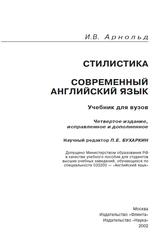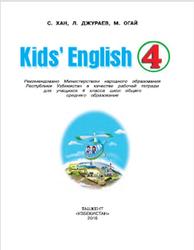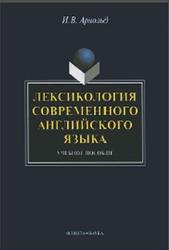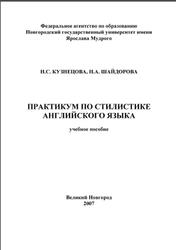Лексикология современного английского языка, Арнольд И.В., 1986.
Учебник посвящен слову как основной единице языка, его семантической и морфологической структуре, особенностям английского словообразования и фразеологии. Английская лексика рассматривается как непрерывно развивающаяся система.
В 3-м издании (2-е—1973 г.) обновлен теоретический и иллюстративный материал, расширены главы, посвященные теории слова и семасиологии.
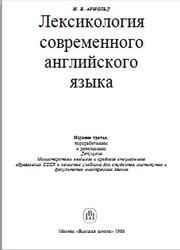
THE DEFINITION OF THE WORD.
Although the borderline between various linguistic units is not always sharp and clear, we shall try to define every new term on its first appearance at once simply and unambiguously, if not always very rigorously. The approximate definition of the term word has already been given in the opening page of the book.
The important point to remember about definitions is that they should indicate the most essential characteristic features of the notion expressed by the term under discussion, the features by which this notion is distinguished from other similar notions. For instance, in defining the word one must distinguish it from other linguistic units, such as the phoneme, the morpheme, or the word-group. In contrast with a definition, a description aims at enumerating all the essential features of a notion.
To make things easier we shall begin by a preliminary description, illustrating it with some examples.
CONTENTS
Preface
Abbreviations
Introduction
Chapter 1. Fundamentals
§1.1 The Object of Lexicology
§1.2 The Theoretical and Practical Value of English Lexicology
§1.3 The Connection of Lexicology with Phonetics, Stylistics, Grammar and Other Branches of Linguistics
§1.4 Types of Lexical Units
§1.5 The Notion of Lexical System
§1.6 The Theory of Oppositions
Part One THE ENGLISH WORD AS A STRUCTURE
Chapter 2. Characteristics of the Word as the Basic Unit of Language
§2.1 The Definition of the Word
§2.2 Semantic Triangle
§2.3 Phonetic, Morphological and Semantic Motivation of Words
Chapter 3. Lexical Meaning and Semantic Structure of English Words
§3.1 Definitions
§3.2 The Lexical Meaning Versus Notion
§3.3 Denotative and Connotative Meaning
§3.4 The Semantic Structure of Polysemantic Words
§3.5 Contextual Analysis
§3.6 Componential Analysis
Chapter 4. Semantic Change
§4.1 Types of Semantic Change
§4.2 Linguistic Causes of Semantic Change
§4.3 Extralinguistic Causes of Semantic Change
Chapter 5. Morphological Structure of English Words. Affixation
§5.1 Morphemes. Free and Bound Forms. Morphological Classification of Words. Word-Families
§5.2 Aims and Principles of Morphemic and Word-Formation Analysis
§5.3 Analysis into Immediate Constituents
§5.4 Derivational and Functional Affixes
§5.5 The Valency of Affixes and Stems. Word-Building Patterns and Their Meaning
§5.6 Classification of Affixes
§5.7 Allomorphs
§5.8 Boundary Cases Between Derivation, Inflection and Composition
§5.9 Combining Forms
§5.10 Hybrids
Chapter 6. Compound Words
§6.1 Definitions and Introductory Remarks
§6.2.1 The Criteria of Compounds
§6.2.2 Semi-Affixes
§6.2.3 “The Stone Wall Problem"
§6.2.4 Verbal Collocations of the Give Up Type
§6.3 Specific Features of English Compounds
§6.4.1 Classification of Compounds
§6.4.2 Compound Nouns
§6.4.3 Compound Adjectives
§6.4.4 Compound Verbs
§6.5 Derivational Compounds
§6.6 Reduplication and Miscellanea of Composition
§6.6.1 Reduplicative Compounds
§6.6.2 Ablaut Combinations
§6.6.3 Rhyme Combinations
§6.7 Pseudo Compounds
§6.8 The Historical Development of English Compounds
§6.9 New Word-Forming Patterns in Composition
Chapter 7. Shortened Words and Minor Types of Lexical Oppositions
§7.1 Shortening of Spoken Words and Its Causes
§7.2 Blending
§7.3 Graphical Abbreviations. Acronyms
§7.4 Minor Types of Lexical Oppositions. Sound Interchange
§7.5 Distinctive Stress
§7.6 Sound Imitation
§7.7 Back-Formation
Chapter 8. Conversion and Similar Phenomena
§8.1 Introductory Remarks
§8.2 The Historical Development of Conversion
§8.3 Conversion in Present-Day English
§8.4 Semantic Relationships in Conversion
§8.5 Substantivation
§8.6 Conversion in Different Parts of Speech
§8.7 Conversion and Other Types of Word-Formation
Chapter 9. Set Expressions
§9.1 Introductory Remarks. Definitions
§9.2 Set Expressions, Semi-Fixed Combinations and Free Phrases
Changeable and Unchangeable Set Expressions
§9.3 Classification of Set Expressions
§9.4 Similarity and Difference between a Set Expression and a Word.
§9.5 Features Enhancing Unity and Stability of Set Expressions
§9.6 Proverbs, Sayings, Familiar Quotations and Clichés
Part Two ENGLISH VOCABULARY AS A SYSTEM
Chapter 10. Homonyms. Synonyms. Antonyms
§10.1 Homonyms
§10.2 The Origin of Homonyms
§10.3 Homonymy Treated Synchronically
§10.4 Synonyms
§10.5 Interchangeability and Substitution
§10.6 Sources of Synonymy
§10.7 Euphemisms
§10.8 Lexical Variants and Paronyms
§10.9 Antonyms and Conversives
Chapter 11. Lexical Systems
§11.1 The English Vocabulary as an Adaptive System. Neologisms
§11.2 Morphological and Lexico-Grammatical Grouping
§11.3 Thematic and Ideographic Groups. The Theories of Semantic Fields. Hyponymy
§11.4 Terminological Systems
§11.5 The Opposition of Emotionally Coloured and Emotionally Neutral Vocabulary
§11.6 Different Types of Non-Semantic Grouping
Chapter 12. The Opposition of Stylistically Marked and Stylistically Neutral Words
§12.1 Functional Styles and Neutral Vocabulary
§12.2 Functional Styles and Registers
§12.3 Learned Words and Official Vocabulary
§12.4 Poetic Diction
§12.5 Colloquial Words and Expressions
§12.6 Slang
Chapter 13. Native Words Versus Loan Words
§13.1 The Origin of English Words
§13.2 Assimilation of Loan Words
§13.3 Etymological Doublets
§13.4 International Words
Chapter 14. Regional Varieties of the English Vocabulary
§14.1 Standard English Variants and Dialects
§14.2 American English
§14.3 Canadian, Australian and Indian Variants
Chapter 15. Lexicography
§15.1 Types of Dictionaries
§15.2 Some of the Main Problems of Lexicography
§15.3 Historical Development of British and American Lexicography
Conclusion
Recommended Reading
Subject Index.
Купить .
Купить .
По кнопкам выше и ниже «Купить бумажную книгу» и по ссылке «Купить» можно купить эту книгу с доставкой по всей России и похожие книги по самой лучшей цене в бумажном виде на сайтах официальных интернет магазинов Лабиринт, Озон, Буквоед, Читай-город, Литрес, My-shop, Book24, Books.ru.
По кнопке «Купить и скачать электронную книгу» можно купить эту книгу в электронном виде в официальном интернет магазине «Литрес», если она у них есть в наличии, и потом ее скачать на их сайте.
По кнопке «Найти похожие материалы на других сайтах» можно найти похожие материалы на других сайтах.
On the buttons above and below you can buy the book in official online stores Labirint, Ozon and others. Also you can search related and similar materials on other sites.
Теги: учебник по английскому языку :: английский язык :: Арнольд
Смотрите также учебники, книги и учебные материалы:
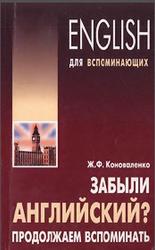 Забыли английский? Продолжаем вспоминать, Коноваленко Ж.Ф., 2007 — Пособие адресовано тем, кто хочет восстановить знания английского языка после некоторого перерыва в практике, чтобы продолжить его изучение в профессиональное … Книги по английскому языку
Забыли английский? Продолжаем вспоминать, Коноваленко Ж.Ф., 2007 — Пособие адресовано тем, кто хочет восстановить знания английского языка после некоторого перерыва в практике, чтобы продолжить его изучение в профессиональное … Книги по английскому языку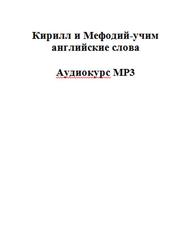 Кирилл и Мефодий-учим английские слова, аудиокурс MP3 — child ребенок aunt тетя uncle дядя nephew племянник niece племянница cousin двоюродная сестра cousin двоюродный брат household домашние (семья). Книги по английскому языку
Кирилл и Мефодий-учим английские слова, аудиокурс MP3 — child ребенок aunt тетя uncle дядя nephew племянник niece племянница cousin двоюродная сестра cousin двоюродный брат household домашние (семья). Книги по английскому языку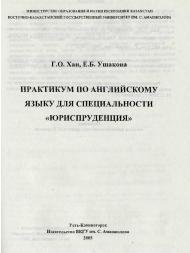 Практикум по английскому языку для специальности «Юриспруденция», Хан Г.О., Ушакова Е.Б., 2005 — Фрагмент из книги. Unit 2. SOMEONE HAD TAKEN IT ГОпе day a few years ago a very funny thing happened … Книги по английскому языку
Практикум по английскому языку для специальности «Юриспруденция», Хан Г.О., Ушакова Е.Б., 2005 — Фрагмент из книги. Unit 2. SOMEONE HAD TAKEN IT ГОпе day a few years ago a very funny thing happened … Книги по английскому языку Учим английский в игровой форме, 10 тем — В гостях у Красной Шапочки. Знакомство с приветственными словами: Hello,hi, good morning, good bye., И гра Тук-Тук (дети выходят за … Книги по английскому языку
Учим английский в игровой форме, 10 тем — В гостях у Красной Шапочки. Знакомство с приветственными словами: Hello,hi, good morning, good bye., И гра Тук-Тук (дети выходят за … Книги по английскому языку
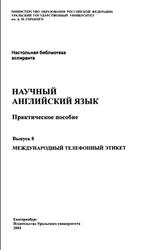 Научный английский язык, выпуск 8, Международный телефонный этикет, Андреева Т.Я., 2003 — Развитие той или иной отрасли знаний невозможно, если она не будет пополняться новой информацией. Значительный вклад в ее развитие принадлежит … Книги по английскому языку
Научный английский язык, выпуск 8, Международный телефонный этикет, Андреева Т.Я., 2003 — Развитие той или иной отрасли знаний невозможно, если она не будет пополняться новой информацией. Значительный вклад в ее развитие принадлежит … Книги по английскому языку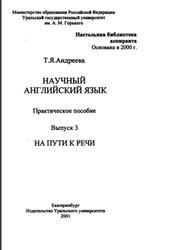 Научный английский язык, выпуск 3, На пути к речи, Андреева Т.Я., 2001 — Практическое пособие На пути к речи является выпуском 3 Настольной библиотеки аспиранта Научный английский язык . Содержащийся в нем материал … Книги по английскому языку
Научный английский язык, выпуск 3, На пути к речи, Андреева Т.Я., 2001 — Практическое пособие На пути к речи является выпуском 3 Настольной библиотеки аспиранта Научный английский язык . Содержащийся в нем материал … Книги по английскому языку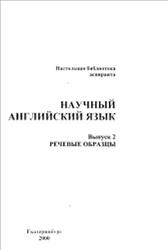 Научный английский язык, выпуск 2, Речевые образцы, Андреева Т.Я., Корлыханова З.А., 2000 — Пособие представляет собой второй выпуск серии Настольная библиотека аспиранта . Целью пособия является развитие навыков устной и письменной научной речи, … Книги по английскому языку
Научный английский язык, выпуск 2, Речевые образцы, Андреева Т.Я., Корлыханова З.А., 2000 — Пособие представляет собой второй выпуск серии Настольная библиотека аспиранта . Целью пособия является развитие навыков устной и письменной научной речи, … Книги по английскому языку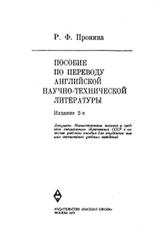 Пособие по переводу английской научно-технической литературы, Пронина Р.Ф., 1973 — Данное пособие представляет собой практическое руководство по переводу английской и американской научно-технической литературы. Пособие состоит из 4-х разделов. В них … Книги по английскому языку
Пособие по переводу английской научно-технической литературы, Пронина Р.Ф., 1973 — Данное пособие представляет собой практическое руководство по переводу английской и американской научно-технической литературы. Пособие состоит из 4-х разделов. В них … Книги по английскому языку

